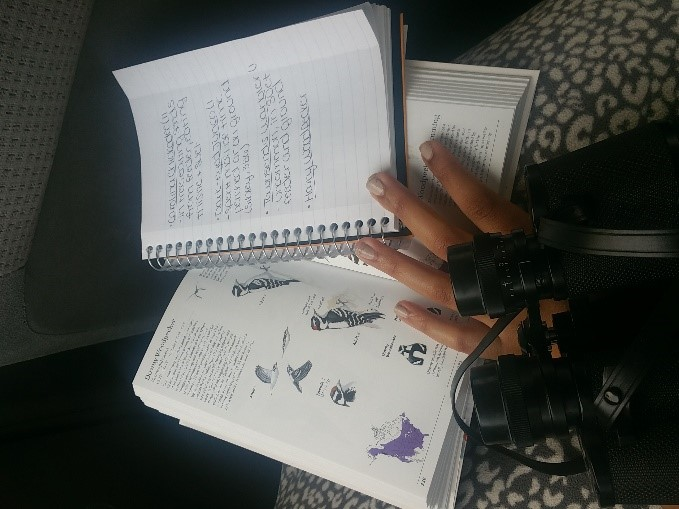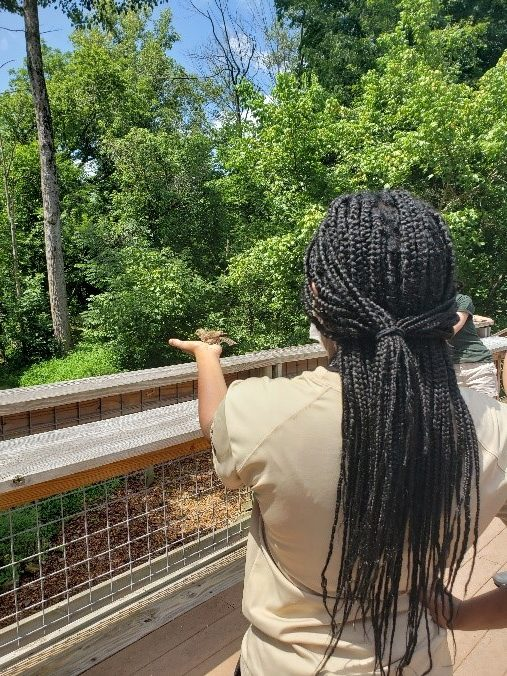The Dirt | Birding 101: A Guide for New Birders

So you want to begin birding! A great choice for many, birding is a recreational activity that gets a ton of individuals outside and exposed to nature while experiencing and learning about many new and exciting bird species.
But how does one exactly begin to “bird?” In this post, I list my top tips for new and beginner birders, as well as explain why and how birding can be important; not only for awareness, but also for science, mental health, and educational purposes.
A Beginner Birders Guide
If you are a new or beginner birder, then you probably can’t wait to get out in nature and discover all of the new and interesting birds! But where does one begin when birding for the first time?
Here are some of my suggestions, from field guides to equipment, to get you started!
Field Guides

Field Guides are a must for any new or beginner birder; they provide identification tips and keys to help you figure out the species of birds you may be seeing. Field guides like Sibley can provide you with descriptive pictures of birds that include a bird’s size or identifiable markings. They can also provide you with a certain bird’s location in the region as well as whether they are a seasonal or year around species.
Mobile Apps
For those who may not want to carry around a heavy or bulky field guide, there is the option of mobile apps! Apps like eBird by the Cornell Lab of Ornithology allow you to not only identify a bird, but also to keep a checklist of species you spot. Be sure to save and submit these checklists, for they are used by scientists and researchers for conservation purposes.
Apps like Merlin Bird I.D. and Audubon Bird Guide can help you identify birds by their song. All of these apps are free to download and are available in your phone’s app store.
Equipment

Along with your field guide or mobile app, remember to bring along a good pair of binoculars for spotting birds from far away. With more experience, birders may want to upgrade to a spotting scope. If you are into photography, I would recommend a wonderful camera; consider characteristics such as the camera body and lens options that will work best for capturing the most outstanding possible images of nature or birds in the wild. To carry all of your birding equipment, a sturdy backpack will come in handy as well! Get inspired to take great bird photos by viewing the Friends of William L. Finley Wildlife Refuge Facebook Page.
Instructional Birding Guidance
As a new or beginner birder, it helps to have assistance and knowledge from someone who has had more experience birding or studies birds themselves. Guided bird walks or instructional courses led by experienced professionals are the way to go if you are in the market to take your birding skills and knowledge to the next level!
Guided Bird Walks
Guided bird walks by a professional or an experienced birder allow for beginners and new birders to experience birding while learning new tips and tricks about how to identify birds by their physical features as well as song. Look into your local Audubon Chapter or Nature Center for opportunities like these. In Corvallis, Neighborhood Naturalist offers monthly Naturalist Adventures and Birding by Ear. Audubon Society of Corvallis offers Beginning Birding classes. These offerings are on hold right now due to the pandemic. This pamphlet, “Birding the Corvallis and Albany areas” is a guide to birding opportunities in the mid-Willamette Valley.
Instructional Programs & Courses
In -person or online courses and programs allow for individuals to gain more knowledge by learning technical terms and identification within the classroom or other educational setting.
Look into the Cornell Lab of Ornithology and Audubon Programs for fellowships and/or apprenticeships. Most of these opportunities allow for you to obtain a certificate upon completion as well!
The Importance of Birding

Besides being a recreational activity, birding is important for many other things; it can contribute to different aspects of science as well as serve as an important tool for mental health and education.
Birding Contributes to Science
Birding can benefit scientists and researchers who study birds, their health, and their communities. Findings from citizen science projects such as Neighborhood Nestwatch in Washington, D.C. allows for researchers to answer questions about avian reproduction and success in urban and suburban areas.
Research centers such as Powdermill Avian Research Center in Rector, Pennsylvania, carry out bird banding, another effective tool that helps researchers collect high-quality data to build a strong and reliable dataset to address specific scientific questions, contribute to conservation efforts, and/or contribute new information about the natural history of birds.
Birding Helps Your Mental Health
Whether you are birding or just taking a trip out in Nature, time outdoors is a wonderful tool for improved mental health. In fact, a study from the University of Exeter in England found that people living in neighborhoods with more birds and tree cover are less likely to have depression, anxiety, and stress. In fact, numerous medical centers have begun prescribing time in nature for patients with physical and mental health concerns.
Birding Serves as an Educational Tool

PC: Lauren D. Pharr
Working towards a more inclusive outdoors is the goal of many organizations. Opportunities to meet Black, Indigenous, and People of Color, or BIPOCs, as well as hold educational events for youth and minorities is a wonderful way to get younger and underrepresented individuals exposed to nature and many occupations. Birding is a great tool to do just that! Hosting events such as bird banding or guided bird walks provides hands-on learning opportunities, gets all people outside, and raises awareness.
Black Birders Week, a weeklong online event founded by Anna Gifty and other members of BlackAFInStem in 2020, celebrated BIPOCs in many wildlife and natural science fields. Many people participated in the event and so many minority individuals were amazed to see that there were other people in this field who looked just like them.
Winter Wildlife Field Days, hosted by William L. Finley National Wildlife Refuge, is a perfect example of a local, family-friendly event that gets young people interested in birding and other nature-based activities. This year, instead of a one-day event at the refuge, it’s a two-week event that everyone is invited to participate in on their own. Pick up a “passport” from one of the parks listed here and access all the fun activities to try on their own – from scavenger hunts to constructing a squirrel nest, extracting strawberry DNA to nature-themed library story times! Whether you are 2 or 92, the list of activities, available in both Spanish and English, is sure to provide opportunities for you to explore the natural world around you!
I hope that these tips will be beneficial to any new or beginner birder and I hope that you will not only become a successful birder and naturalist, but will also become an advocate for inclusion in nature as well!

